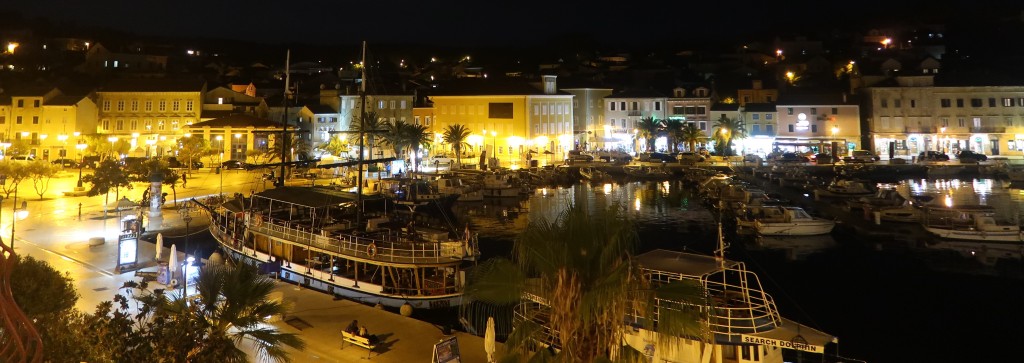
Like so many of Croatia’s islands, Lošinj is long, thin and easily accessible. I arrived via a flight to Pula and then a direct ferry, you can also reach this island by flying into Rijeka and taking a bus or ferry, or by island-hopping from Zadar. I’ve lost count of the Croatian islands I’ve visited, but I do now notice how different they can be from one another. Lošinj’s key selling point? Nature.
This 74.36 km2 island is marketed as ‘The island of vitality’. There are hundreds of medicinal plants growing here, over 200 days of sunshine annually, a renowned marine biology institute, a choice of highly-rated spa hotels, and 280km of hiking trails for a variety of abilities. Being a hiker, it was the latter that I most enjoyed.
By foot to faraway beaches

It was a pleasant surprise to discover a concrete trail running around almost the entire north western coast of the island. This infrastructure meant that remote beaches were accessible to most (although I’m not sure how easy it would be to use them in, say, a wheelchair), and cyclists could enjoy traffic-free routes to some stunning locations. The trails running through the island’s interior are sometimes steep and lead through verdant forests. Many are old paths threading between stone walls erected centuries ago.
From Mali Lošinj you can walk along easy coastal trails for hours and still come across beaches where showers and changing areas have been constructed. I was most grateful for the occasional short ladders into the sea, which made snorkelling a simple endeavour.
Beyond a naturist beach the trail turns from concrete to dirt, but it’s still very easy to follow and, having continued along it for many hours, I found myself all alone on gorgeous white stone beaches lapped by water so clear that it felt as though I was flying high above the seabed when I went for my frequent dips.
Keeping it clean and clear

I met with the Blue World Institute (BWI) in the small and very cute fishing village of Veli Lošinj to find out about the work they did, and in the hope that I could get an article commissioned about their impressive efforts. The BWI has been gathering data on bottlenose dolphins for 34 years; so rich is this data that it’s used by marine institutes the world over. They work closely with the tourism industry to protect marine wildlife throughout the Adriatic, an important job especially in July and August when the sea is crammed with noisy motorboats.
My visit coincided with the Festival of the Sea, held in the island’s main town Mali Lošinj. Among concerts and seafood stalls I met with the local astronomy group, who explained to me how light pollution has become a big problem on the island. Hopefully the authorities here will listen to the astronomers’ concerns – much as I appreciate all of that infrastructure around the coast there is a point at which maintaining the island’s natural wonders will need to be prioritised.
Floating in Čikat Bay, my mouth so close to the still water that I could hear my breath reflected back at me, I was fully aware of the importance of preserving this island for both humans and wildlife. This picturesque bay is surrounded by luxurious old villas and backed by pine-clad hills, both currently existing in tenuous harmony.
Mali Lošinj

What I really love about the cute towns on Croatian islands is how Romans, Venetians and Austrian-Hungarians created calm harbours, taming the sea so that sailing vessels could easily glide up to warehouses and colourful villas. Mali Lošinj is just such a town. At night boats bob in the black water as lively restaurants buzz with patrons enjoying fresh pasta and seafood.
In town you’ll find the exceptionally good and creative MobyDick Gelateria, plus the Deveron restaurant – I highly recommend the truffle-laced Pljukanci. Along the quayside is the Museum of Apoxyomenos which contains a Greek bronze statue dating to the 2nd or 1st century BC, found in the waters off of Vele Orjule, an uninhabited islet next to Lošinj.
When to go
From May until October average high temperatures here will be at least 20C (68F), which means you have May, June, September and October to come to this warm place without the vast crowds and high prices of peak summer months.

Add a visit to Lošinj as part of this Slovenia and Croatia itinerary
There’s a huge range of accommodation on the island, from camping to 5* boutique hotels. I stayed at the Hotel Apoksiomen which is the best choice for a mid-range budget if you want to stay in town.
I recommend flying to Pula and spending a night to see the ancient streets and immense coliseum there before catching the ferry to Lošinj. Good value flights can also be found to Rijeka.
⛴️
From Pula you can get a direct ferry to Mali Lošinj with Krilo Ferries.
🚌
Arriva run a direct ferry between Mali Lošinj and Zagreb, stopping off at Cres (which I highly recommend you do) and Rijeka.
